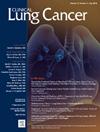医疗补助扩展对肺癌患者接受辅助化疗的影响。
IF 3.3
3区 医学
Q2 ONCOLOGY
引用次数: 0
摘要
目的我们旨在利用一个具有全国代表性的数据库,研究医疗补助扩展对符合条件的患者接受辅助化疗的影响:我们对 2006 年至 2019 年期间的国家癌症数据库(NCDB)进行了回顾性审查。纳入了临床表现为 T1-T3、N1 和 M0 的患者。结节病或肿瘤大于4厘米的患者有资格接受辅助治疗。收集了人口统计学和临床信息。结果显示,共有9954名符合条件的患者接受了辅助化疗:在2014年1月或之后扩大医疗补助覆盖范围的州,共有9954名符合条件的患者接受了治疗,其中4809名患者在扩大前几年(2012-2013年)接受了治疗,5145名患者在扩大后几年(2017-2018年)接受了治疗。医疗补助扩展后,符合条件的患者更有可能接受辅助治疗(70.2% vs. 62.3%; P < .001)。与扩展前相比,接受辅助治疗的患者在扩展后更有可能使用医疗补助保险(7.8% 对 5%,P < .001)。在仅使用医疗补助保险的患者中,医疗补助扩展后在切除术后 8 周内开始辅助治疗的患者比例更高(46.6% 对 38.3%,P = .048)。在扩大医保范围的州和未扩大医保范围的州之间,辅助治疗率从扩大医保范围前到扩大医保范围后的变化差异为 1.25% (95% Bootstrap CI -0.36% to -3.18%)。扩张后,扩张州的生存率略有提高:结论:医疗补助计划的扩大似乎与获得医疗服务的机会增加有关,符合条件的患者接受辅助系统治疗的机会增加就说明了这一点。本文章由计算机程序翻译,如有差异,请以英文原文为准。
The Role of Medicaid Expansion on the Receipt of Adjuvant Chemotherapy in Patients With Lung Cancer
Objective
We aimed to utilize a nationally representative database to study the effect of Medicaid expansion on the receipt of adjuvant chemotherapy in eligible patients.
Materials and Methods
Retrospective review of the National Cancer Database (NCDB) was performed between 2006 and 2019. Patients with clinical T1-T3, N1, and M0 were included. Patients with nodal disease or tumors > 4 cm were eligible for adjuvant therapy. Demographic and clinical information were collected. A difference-in-difference analysis was performed to compare changes in the rate of adjuvant chemotherapy.
Results
Total 9954 eligible patients were treated in states that expanded Medicaid coverage in January 2014 or later, with 4809 patients treated in the pre-expansion years (2012-2013) and 5145 patients treated in the postexpansion years (2017-2018). Following Medicaid expansion, eligible patients were more likely to receive adjuvant therapy (70.2% vs. 62.3%; P < .001). Compared with the pre-expansion period, patients who received adjuvant therapy were more likely to use Medicaid insurance postexpansion (7.8% vs. 5%, P < .001). Among patients using Medicaid coverage only, a greater percentage started adjuvant therapy within 8 weeks of resection following Medicaid expansion (46.6% vs. 38.3%, P = .048). The observed difference-in-difference in the change in adjuvant therapy rate from the pre-expansion period to the postexpansion period between expansion and nonexpansion states was 1.25% (95% Bootstrap CI −0.36% to −3.18%). There was a modest survival benefit in expansion states postexpansion.
Conclusion
Medicaid expansion appears to be associated with increased access to care, as shown by the increased receipt of adjuvant systemic therapy in eligible patients.
求助全文
通过发布文献求助,成功后即可免费获取论文全文。
去求助
来源期刊

Clinical lung cancer
医学-肿瘤学
CiteScore
7.00
自引率
2.80%
发文量
159
审稿时长
24 days
期刊介绍:
Clinical Lung Cancer is a peer-reviewed bimonthly journal that publishes original articles describing various aspects of clinical and translational research of lung cancer. Clinical Lung Cancer is devoted to articles on detection, diagnosis, prevention, and treatment of lung cancer. The main emphasis is on recent scientific developments in all areas related to lung cancer. Specific areas of interest include clinical research and mechanistic approaches; drug sensitivity and resistance; gene and antisense therapy; pathology, markers, and prognostic indicators; chemoprevention strategies; multimodality therapy; and integration of various approaches.
 求助内容:
求助内容: 应助结果提醒方式:
应助结果提醒方式:


